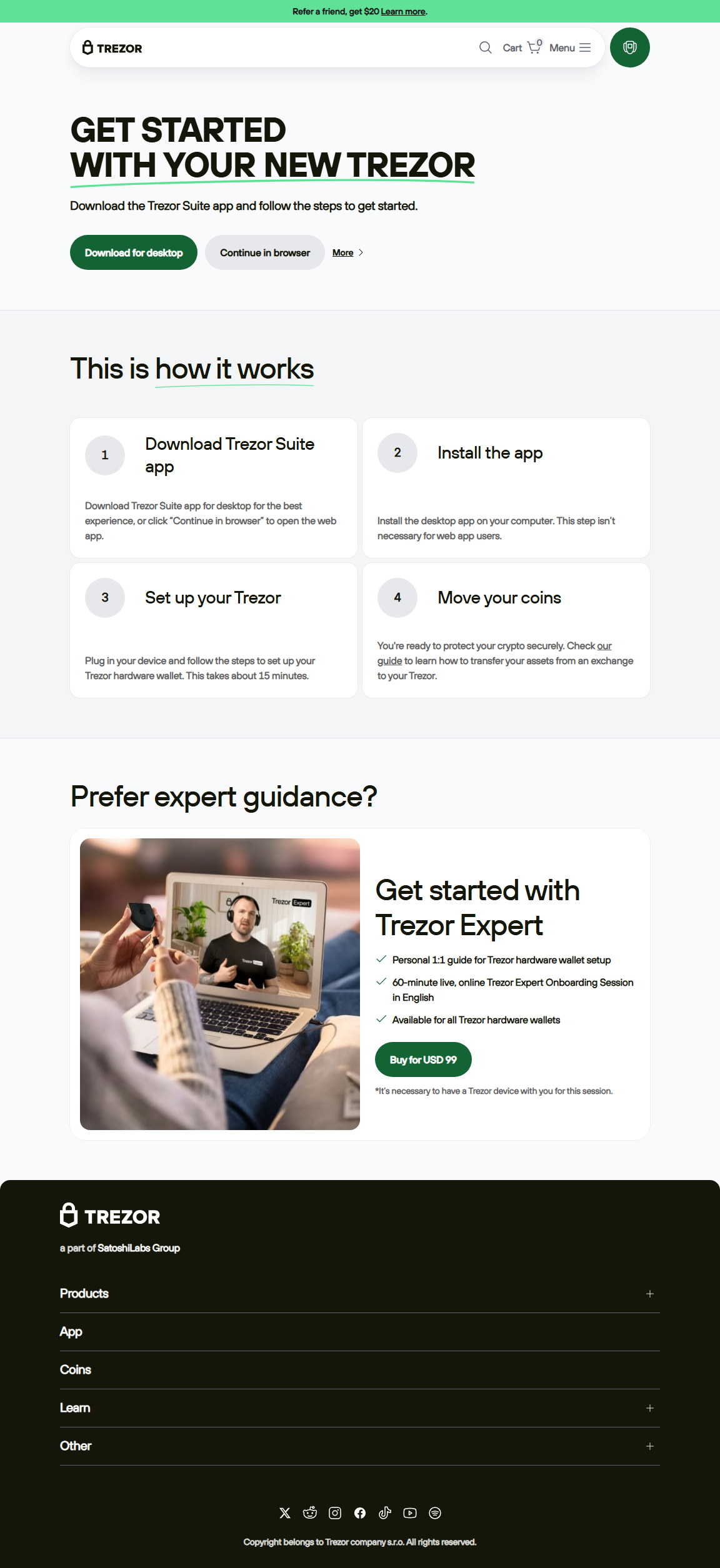Trezor Login Explained: The Future of Passwordless Crypto Access
No accounts. No passwords. Just a secure bridge between you and your crypto. Let’s redefine what “login” means in the world of hardware wallets.
Why There's No "Trezor Login" — And Why That’s a Good Thing
For anyone new to Trezor, the term "Trezor login" can be a bit confusing. You might expect a screen where you input a username and password, just like logging into a bank or crypto exchange. But that’s not how Trezor works — and that’s by design.
Trezor is a non-custodial hardware wallet. This means you are the bank. There are no Trezor accounts. No centralized databases. Your wallet is accessed only through physical, local interaction with your Trezor device — typically through the Trezor Suite app or web interface.
🧠 Key Insight: Login Without Logging In
“Logging in” to Trezor is not about credentials. It’s about proving ownership through secure hardware interaction — your PIN, your recovery phrase, and your optional passphrase are your login credentials.
How to Access Your Wallet Using Trezor
Step 1: Plug In Your Trezor Device
Connect your Trezor Model One or Model T to your computer using a trusted USB cable. Always use the original or a certified cable to ensure data connectivity.
Step 2: Launch Trezor Suite
Trezor Suite is the official desktop (and browser-compatible) application for managing your wallet. Open it and wait for it to detect your device.
Step 3: Authenticate with Your PIN
Use the randomized on-screen grid and your Trezor screen to input your PIN. This is your first layer of defense. After several incorrect attempts, the device will wipe itself.
Step 4: Enter Your Passphrase (Optional)
If you enabled a passphrase (an advanced security feature), you’ll be asked to input it. This acts as a second wallet layer — without it, your “hidden” wallet is invisible and inaccessible.
Step 5: Manage Your Crypto
You now have access to your portfolio, balances, transaction history, and more — directly from your hardware device, without ever logging in to a server.
🆚 Trezor Access vs Exchange Logins
| Feature | Trezor Login | Exchange Login |
|---|---|---|
| Authentication | PIN + hardware + optional passphrase | Email + password + 2FA (sometimes) |
| Private Key Storage | Offline (on device) | Online (custodial) |
| Recovery | Recovery seed only | Email/password reset |
| Risk of Hack | Very low (unless seed is compromised) | High (centralized target) |
| Who Controls the Wallet? | You | The exchange |
⚠️ Avoid These Trezor Login Pitfalls
- Never Google “Trezor login”: Fake phishing sites prey on new users. Bookmark
suite.trezor.io. - Never enter your seed online: Your seed phrase should only be used offline during recovery, never for logging in.
- Don’t lose your seed: Without it, your wallet cannot be recovered — not even by Trezor.
What Happens If I Forget My PIN?
If you forget your PIN, you’ll need to wipe the device and restore your wallet using your recovery seed. Your funds are still safe — they live on the blockchain — but without the correct seed phrase, they’re gone forever.
This is why many advanced users keep their seed phrase stored in fireproof safes or metal wallets designed to survive physical disasters.
Trezor Login & Web3 Integration
Using Trezor Suite’s built-in Web3 features, or connecting via WalletConnect and browser extensions, you can log in to dApps like Uniswap, Aave, or OpenSea — all while using your Trezor device as a secure key-signing tool.
You’ll be asked to confirm each transaction physically on your Trezor — this ensures no malicious browser script can drain your wallet behind your back.
✅ Pro Tips for Mastering Trezor Login
- Enable passphrase for an invisible “decoy” wallet layer
- Use Trezor Suite desktop app for added phishing protection
- Test recovery on a second device to ensure your seed works
- Keep your firmware updated to prevent known exploits
- Use a metal backup for long-term seed storage
Frequently Asked Questions (FAQs)
Can I log into Trezor from my phone?
Yes, with limited functionality. You can use apps like Metamask Mobile + WalletConnect, or third-party apps that support Trezor via OTG cables. However, full Trezor Suite is desktop-focused.
Is there any online login page?
No. There is no cloud account or online login for Trezor. Always use suite.trezor.io or the desktop Suite app. Anything else is likely a scam.
How do I know I'm using the real Trezor Suite?
Download only from trezor.io. Check the SSL certificate and avoid clicking links in emails or ads.
Conclusion: You Are the Login
With Trezor, login isn't about entering credentials — it’s about cryptographic proof of ownership. The physical device, your PIN, and your recovery phrase are the keys to your sovereignty.
There's no “forgot password” safety net. That’s both the freedom and responsibility of self-custody.
Trezor login is more than access — it’s ownership, empowerment, and the purest form of digital independence.
